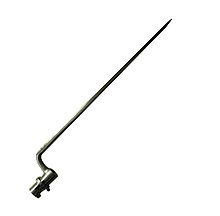
Back Acoblament en baioneta Catalan Bajonettverschluss German Bajoneta kunigo EO Bayoneta (conexión) Spanish Bajonettühendus ET اتصال جزری FA Bajonetti Finnish Baïonnette (fixation) French Innesto a baionetta Italian Bajonetsluiting Dutch
This article needs additional citations for verification. (April 2012) |




A bayonet mount (mainly as a method of mechanical attachment, such as fitting a lens to a camera using a matching lens mount) or bayonet connector (for electrical use) is a fastening mechanism consisting of a cylindrical male side with one or more radial pins, and a female receptor with matching L-shaped slot(s) and with spring(s) to keep the two parts locked together. The slots are shaped like a capital letter L with serif (a short upward segment at the end of the horizontal arm); the pin slides into the vertical arm of the L, rotates across the horizontal arm, then is pushed slightly upwards into the short vertical "serif" by the spring; the connector is no longer free to rotate unless pushed down against the spring until the pin is out of the "serif".
The bayonet mount is the standard light bulb fitting in the United Kingdom and in many countries that were members of the British Empire including Australia, Hong Kong, Fiji,[1] India, Pakistan, Sri Lanka, Ireland and New Zealand, parts of the Middle East and Africa and, historically, in France and Greece.